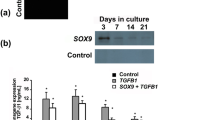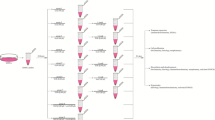ABSTRACT
Purpose
This study aims to deliver both transforming growth factor β3 (TGF-β3) and shRNA targeting type I collagen (Col I) by optimal construction and application of various dual-functioning lentiviral vectors to induce Col I-suppressed chondrogenesis in synovium-derived mesenchymal stem cells (SMSCs).
Methods
We constructed four lentiviral vectors (LV-1, LV-2, LV-3 and LV-4) with various arrangements of the two expression cassettes in different positions and orientations. Col I inhibition efficiency and chondrogenic markers were assessed with qPCR, ELISA and staining techniques. Among the four vectors, LV-1 has two distant and reversely oriented cassettes, LV-2 has two distant and same-oriented cassettes, LV-3 has two proximal and reversely oriented cassettes, and LV-4 has two proximal and same-oriented cassettes. Col I and chondrogenic markers, including type II collagen (Col II), aggrecan and glycosaminoglycan (GAG), were examined in SMSCs cultured in 3-D alginate hydrogel.
Results
All of the four vectors showed distinct effects in Col I level as well as diverse inductive efficiencies in upregulation of the cartilaginous markers. Based on real-time PCR results, LV-1 was optimal towards Col I-suppressed chondrogenesis.
Conclusion
LV-1 vector is competent to promote Col I-suppressed chondrogenesis in SMSCs.





Similar content being viewed by others
Abbreviations
- Col I:
-
type I collagen
- Col II:
-
type II collagen
- LV-dual:
-
recombinant lentiviral vector that expresses both shRNA targeting type I collagen and TGF- β3
- LV-T:
-
recombinant lentiviral vector that specifically expresses TGF-β3
- shRNA:
-
short hairpin RNA
- SMSC:
-
synovium-derived mesenchymal stem cell
- TGF-β3:
-
transforming growth factor-β3
REFERENCES
Schulzand RM, Bader A. Cartilage tissue engineering and bioreactor systems for the cultivation and stimulation of chondrocytes. Eur Biophys J. 2007;36:539–68.
Buckwalter JA. Articular cartilage injuries. Clin Orthop Relat Res. 2002;21-37.
Fan J, Varshney RR, Ren L, Cai D, Wang DA. Synovium-derived mesenchymal stem cells: a new cell source for musculoskeletal regeneration. Tissue Eng Part B Rev. 2009;15:75–86.
Chuang CK, Sung LY, Hwang SM, Lo WH, Chen HC, Hu YC. Baculovirus as a new gene delivery vector for stem cell engineering and bone tissue engineering. Gene Ther. 2007;14:1417–24.
Hao J, Varshney RR, Wang DA. Engineering osteogenesis and chondrogenesis with gene-enhanced therapeutic cells. Curr Opin Mol Ther. 2009;11:404–10.
Park JS, Woo DG, Yang HN, Lim HJ, Chung HM, Park KH. Heparin-bound transforming growth factor-beta3 enhances neocartilage formation by rabbit mesenchymal stem cells. Transplantation. 2008;85:589–96.
RR Varshney, R Zhou, J Hao, SS Yeo, WH Chooi, J Fan, DA Wang: Chondrogenesis of synovium-derived mesenchymal stem cells in gene-transferred co-culture system. Biomaterials. 31: 6876-91.
Mayne R, Vail MS, Mayne PM, Miller EJ. Changes in type of collagen synthesized as clones of chick chondrocytes grow and eventually lose division capacity. Proc Natl Acad Sci U S A. 1976;73:1674–8.
Yokoyama A, Sekiya I, Miyazaki K, Ichinose S, Hata Y, Muneta T. In vitro cartilage formation of composites of synovium-derived mesenchymal stem cells with collagen gel. Cell Tissue Res. 2005;322:289–98.
Zhang F, Yao Y, Hao J, Zhou R, Liu C, Gong Y, Wang DA. A dual-functioning adenoviral vector encoding both transforming growth factor-beta3 and shRNA silencing type I collagen: construction and controlled release for chondrogenesis. J Control Release. 142:70–7.
Yao Y, Wang C, Varshney RR, Wang DA. Antisense makes sense in engineered regenerative medicine. Pharm Res. 2009;26:263–75.
Brantl S. Antisense-RNA regulation and RNA interference. Biochim Biophys Acta. 2002;1575:15–25.
Spector JA, Mehrara BJ, Luchs JS, Greenwald JA, Fagenholz PJ, Saadeh PB, et al. Expression of adenovirally delivered gene products in healing osseous tissues. Ann Plast Surg. 2000;44:522–8.
Liand F, Mahato RI. Bipartite vectors for co-expression of a growth factor cDNA and short hairpin RNA against an apoptotic gene. J Gene Med. 2009;11:764–71.
Yao Y, Zhang F, Zhou R, Su K, Fan J, Wang DA. Effects of combinational adenoviral vector-mediated TGF beta 3 transgene and shRNA silencing type I collagen on articular chondrogenesis of synovium-derived mesenchymal stem cells. Biotechnol Bioeng. 106:818–28.
De Bari C, Dell'Accio F, Tylzanowski P, Luyten FP. Multipotent mesenchymal stem cells from adult human synovial membrane. Arthritis Rheum. 2001;44:1928–42.
Ameer GA, Mahmood TA, Langer R. A biodegradable composite scaffold for cell transplantation. J Orthop Res. 2002;20:16–9.
Sah RL, Kim YJ, Doong JY, Grodzinsky AJ, Plaas AH, Sandy JD. Biosynthetic response of cartilage explants to dynamic compression. J Orthop Res. 1989;7:619–36.
Farndale RW, Buttle DJ, Barrett AJ. Improved quantitation and discrimination of sulphated glycosaminoglycans by use of dimethylmethylene blue. Biochim Biophys Acta. 1986;883:173–7.
Freed LE, Marquis JC, Nohria A, Emmanual J, Mikos AG, Langer R. Neocartilage formation in vitro and in vivo using cells cultured on synthetic biodegradable polymers. J Biomed Mater Res. 1993;27:11–23.
Wilson C, Bellen HJ, Gehring WJ. Position effects on eukaryotic gene expression. Annu Rev Cell Biol. 1990;6:679–714.
Wang P, Yang J, Ishihama A, Pittard AJ. Demonstration that the TyrR protein and RNA polymerase complex formed at the divergent P3 promoter inhibits binding of RNA polymerase to the major promoter, P1, of the aroP gene of Escherichia coli. J Bacteriol. 1998;180:5466–72.
Callen BP, Shearwin KE, Egan JB. Transcriptional interference between convergent promoters caused by elongation over the promoter. Mol Cell. 2004;14:647–56.
Adhyaand S, Gottesman M. Promoter occlusion: transcription through a promoter may inhibit its activity. Cell. 1982;29:939–44.
Prescottand EM, Proudfoot NJ. Transcriptional collision between convergent genes in budding yeast. Proc Natl Acad Sci U S A. 2002;99:8796–801.
Epshtein V, Toulme F, Rahmouni AR, Borukhov S, Nudler E. Transcription through the roadblocks: the role of RNA polymerase cooperation. EMBO J. 2003;22:4719–27.
Han Y, Lin YB, An W, Xu J, Yang HC, O'Connell K, et al. Orientation-dependent regulation of integrated HIV-1 expression by host gene transcriptional readthrough. Cell Host Microbe. 2008;4:134–46.
Hu X, Eszterhas S, Pallazzi N, Bouhassira EE, Fields J, Tanabe O, et al. Transcriptional interference among the murine beta-like globin genes. Blood. 2007;109:2210–6.
Bhosaleand AM, Richardson JB. Articular cartilage: structure, injuries and review of management. Br Med Bull. 2008;87:77–95.
ACKNOWLEDGEMENTS
This research was financially supported by AcRF Tier 1 Grant RG64/08, Ministry of Education (MoE), and NMRC/EDG/1001/2010, Singapore.
Author information
Authors and Affiliations
Corresponding author
Electronic supplementary material
Below is the link to the electronic supplementary material.
Esm 1
(DOCX 374 kb)
Rights and permissions
About this article
Cite this article
Zhang, F., Yao, Y., Zhou, R. et al. Optimal Construction and Delivery of Dual-Functioning Lentiviral Vectors for Type I Collagen-Suppressed Chondrogenesis in Synovium-Derived Mesenchymal Stem Cells. Pharm Res 28, 1338–1348 (2011). https://doi.org/10.1007/s11095-010-0305-5
Received:
Accepted:
Published:
Issue Date:
DOI: https://doi.org/10.1007/s11095-010-0305-5




